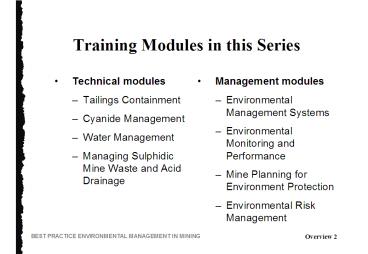Training Modules in this Series - PowerPoint PPT Presentation
1 / 18
Title:
Training Modules in this Series
Description:
To promote understanding of the concept of best practice ... 'Best practice' is the best way of doing things. ... 'Best practice' is identified by bench-marking ... – PowerPoint PPT presentation
Number of Views:108
Avg rating:3.0/5.0
Title: Training Modules in this Series
1
Training Modules in this Series
- Technical modules
- Tailings Containment
- Cyanide Management
- Water Management
- Managing Sulphidic Mine Waste and Acid Drainage
- Management modules
- Environmental Management Systems
- Environmental Monitoring and Performance
- Mine Planning for Environment Protection
- Environmental Risk Management
2
Aims of this Module
- To promote understanding of the concept of best
practice - To introduce important environmental ideas
- Sustainable development
- Biodiversity
- Precautionary principle
- To introduce the training kit
3
What is Best Practice?
- Best practice is the best way of doing things.
- BPEM in mining protects the environment and
reduces the impacts of mining by following the
principles of sustainable development. - Best practice is identified by bench-marking
the performance of companies in an industry.
4
Why strive for best practice?
5
Best Practice Environmental Management in Mining
Booklet Series
- Series of booklets produced by the Australian
Government and the Australian mining industry - Target audience managers with environmental
responsibilities - Practical techniques
- Guidance for managing environmental impacts
- Provide practical advice on understanding and
responding to environmental problems
6
BPEM in Mining Booklets
- Over 20 booklets covering
- Management topics
- Environmental management systems
- Mine planning
- Community consultation
- Environmental auditing
- Cleaner production
- Technical topics
- Tailings containment
- Rehabilitation and revegetation
- Hazardous materials
- Noise, vibration and air blast
- Dust control
7
What is Sustainable Development?
- Sustainable development was first defined in
Brundtland Report - Development that meets the needs of the present
without compromising the ability of future
generations to meet their own needs.
- Another description says that
- The goal of ecologically sustainable development
is to achieve development that improves the total
quality of life, both now and in the future, in a
way that maintains the ecological processes on
which life depends.
8
What is Sustainable Development?
Social system To improve the health, income and l
iving conditions of the poor majority
Economic system To accelerate economic growth wit
h greater equity and self-reliance
Natural system To ensure equitable and sustainabl
e use of the environment and natural resources
for the benefit of present and future generations
Sustainable development
9
Objectives of Sustainable Development
- Improve the well-being and welfare of individuals
and the community by following a path of economic
development that protects the welfare of future
generations - Ensure equity within this generation and between
generations - Protect biological diversity
- Maintain essential ecological processes and life
support systems.
10
Precautionary Approach
In order to protect the environment, the
precautionary approach shall be widely applied by
States according to their capabilities. Where
there are threats of serious or irreversible
damage, lack of full scientific certainty shall
not be used as a reason for postponing
cost-effective measures to prevent environmental
degradation. Principle 15, Rio Declaration
11
Concepts that Underpin the Precautionary Approach
- Valuing environmental assets
- Involving the community in decision-making
- Developing environmentally sound international
competitiveness and an economy that can enhance
environment protection
- When setting policies, actions, activities
consider short-term and long-term - Economic goals
- Environmental goals
- Social goals
- Equity goals
- Recognising the global dimension of impacts on
the environment
12
How can the Precautionary Approach be Applied to
Mining? (1)
- Adopting environmental codes of practice
- Consulting with key stakeholders
- Objective and comprehensive environmental
impact and risk assessment studies - Implementing environmental management systems
13
How can the Precautionary Approach be Applied to
Mining? (2)
- Participating in industry networks for
environmental review, education and
knowledge-sharing - Setting targets for environmental protection to
the highest level technically achievable - Constantly reviewing technical developments
which could be applied to further reduce impacts
or the risk of impacts
14
What is Biological Diversity (Biodiversity)?
- The different species (types of living things) in
an area (species diversity) - This includes plants, animals and
micro-organisms - The differences that exist within a species
(genetic diversity) - The different habitats and ecosystems in an area
(ecosystem diversity)
15
Why is Biodiversity Important?
- Healthy ecosystems and ecosystem services
- Providing food, clothing, other raw materials
- Controlling pest plants, animals and diseases
- Resource for natural compounds
- Beauty, tranquillity, ethical values
16
Impacts of Mining on the Environment
- Wind and water erosion
- Contamination of surface water or ground
water - Changes to flow rate of surface or ground
water - Damage to soils
- Air pollution
- Noise or vibration
- Tailings
- Acid mine drainage
- Loss of flora and fauna
- Damage to heritage sites.
17
What is Required for BPEM in Mining?
- Leadership by senior management
- Recognise environment as an opportunity not a
threat - Excellence in business and the environment are
twin goals - People work together to achieve these goals
- Clear understanding of environmental impacts
and responsibilities
- Recognition of environmental initiatives by
employees - Continual improvement of systems and
performance including awareness and training - Acknowledge and address the concerns of both
shareholder and stakeholder groups
18
Training Modules in this Series
- These modules have been developed to assist
organisations to promote and deliver successful
environmental training programs - Training is an important tool in achieving best
practice environmental management































